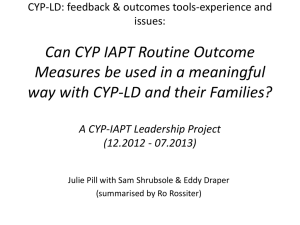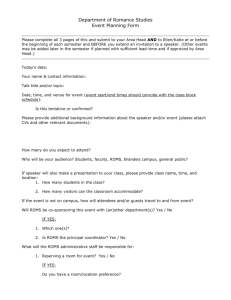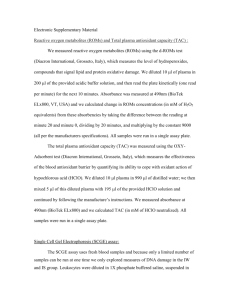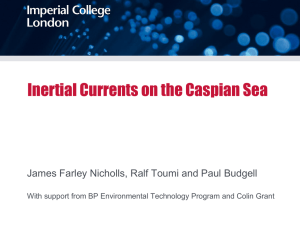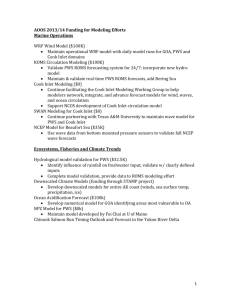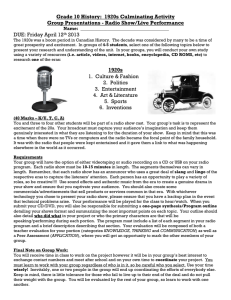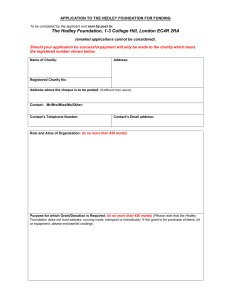Supplemental Material, #1
advertisement
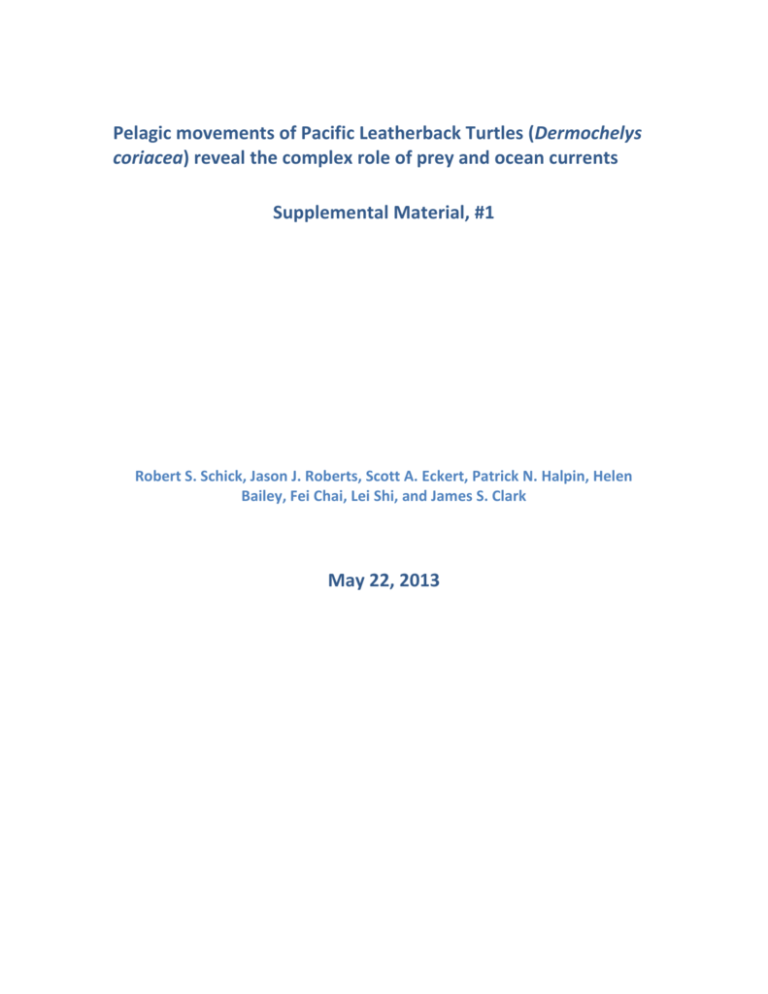
Pelagic movements of Pacific Leatherback Turtles (Dermochelys coriacea) reveal the complex role of prey and ocean currents Supplemental Material, #1 Robert S. Schick, Jason J. Roberts, Scott A. Eckert, Patrick N. Halpin, Helen Bailey, Fei Chai, Lei Shi, and James S. Clark May 22, 2013 Methods: Data Summary – Environmental Variables Many studies have investigated the environmental conditions encountered by migrating marine turtles by spatiotemporally intersecting the turtles’ tracks with time-series maps of oceanographic parameters sensed remotely by satellites (Godley et al. 2008). Modern satellites gather a variety of potentially useful parameters, including sea including sea surface temperature, chlorophyll-a concentration, height, and roughness. From these, additional parameters can be inferred or modeled, including net primary productivity, surface geostrophic currents and winds vectors, and eddy kinetic energy. Remote sensing provides relatively accurate values but suffers from several limitations. Remote sensing is based on measuring the intensity of specific wavelengths of electromagnetic radiation received by a satellite or other distant sensor. Some wavelengths cannot pass through clouds, including the thermal and visible wavelengths needed to estimate ocean temperature and chlorophyll concentration. For parameters based on these wavelengths, no data can be collected by satellites when clouds obscure the ocean. Secondly, present-day technology can only measure characteristics of the ocean surface. No measurements of the depths can be made. Finally, while present-day remote sensing methods can estimate chlorophyll concentration, an indicator of the presence of phytoplankton, no datasets quantifying the presence of higher-order organisms are widely available. To work around these limitations, we obtained environmental covariates from ROMS-CoSiNE, a 4-dimensional biophysical simulation of the Pacific Ocean that couples the Carbon, Si(OH)4, Nitrogen Ecosystem model (CoSiNE; Figure 1) (Chai et al. 2002; Dugdale et al. 2002) to the Regional Ocean Modeling System (ROMS) (Shchepetkin and McWilliams 2005). ROMS simulates the physical ocean dynamics while CoSiNE simulates the flows of various nutrients up through the first two trophic levels of the pelagic marine ecosystem. The composite simulation has four dimensions—longitude, latitude, depth, and time, or x, y, z, and t—with x and y resolutions of 13.8 km, a t resolution of 3 days, and 30 z levels vertically spaced according to a terrain-following algorithm (Figure 2) designed to efficiently capture vertical variability in properties of the water column. The simulation’s spatiotemporal extent encloses all of our turtle tracks, covering 100 °E - °70 W, 45 °S - 65 °N, 1991-2008, from the ocean surface to the ocean floor. We used four physical variables and four biological variables from ROMS-CoSiNE as covariates our movement models (Table 1; Figure 3; Figure 4). Of particular interest was the density of meso-zooplankton. (Fossette et al. 2010) suggested this as a proxy for the density of jellyfish, the primary prey of leatherbacks, and offered corroborating evidence for north Atlantic leatherbacks in the form of maps of foraging success (predicted from turtle swimming velocity and straightness) that appeared to partially overlap a map of annual zooplankton biomass developed by (Strömberg et al. 2009). A goal of our study was to extend this idea and test it quantitatively for eastern Pacific leatherbacks. References Chai, F., R. C. Dugdale, T. H. Peng, F. P. Wilkerson and R. T. Barber (2002). "Onedimensional ecosystem model of the equatorial Pacific upwelling system. Part I: model development and silicon and nitrogen cycle." Deep Sea Research Part II: Topical Studies in Oceanography 49(13-14): 2713-2745. Chai, F., M.-S. Jiang, Y. Chao, R. C. Dugdale, F. Chavez and R. T. Barber (2007). "Modeling responses of diatom productivity and biogenic silica export to iron enrichment in the equatorial Pacific Ocean." Global Biogeochemical Cycles 21(3): GB3S90. Dugdale, R. C., R. T. Barber, F. Chai, T. H. Peng and F. P. Wilkerson (2002). "Onedimensional ecosystem model of the equatorial Pacific upwelling system. Part II: sensitivity analysis and comparison with JGOFS EqPac data." Deep Sea Research Part II: Topical Studies in Oceanography 49(13-14): 27472768. Fossette, S., V. J. Hobson, C. Girard, B. Calmettes, P. Gaspar, J.-Y. Georges and G. C. Hays (2010). "Spatio-temporal foraging patterns of a giant zooplanktivore, the leatherback turtle." Journal of Marine Systems 81: 225-234. Godley, B. J., J. M. Blumenthal, A. C. Broderick, M. S. Coyne, M. H. Godfrey, L. A. Hawkes and M. J. Witt (2008). "Satellite tracking of sea turtles: Where have we been and where do we go next?" Endangered Species Research 4: 3-22. Shchepetkin, A. F. and J. C. McWilliams (2005). "The regional oceanic modeling system (ROMS): a split-explicit, free-surface, topography-followingcoordinate oceanic model." Ocean Modelling 9(4): 347-404. Strömberg, K. H. P., T. J. Smyth, J. I. Allen, S. Pitois and T. D. O'Brien (2009). "Estimation of global zooplankton biomass from satellite ocean colour." Journal of Marine Systems 78(1): 18-27. Tables Table 1. Variables from the ROMS-CoSiNE simulation used in this study. The variable names were generated by prepending ROMS_ to the original variable names present in the ROMS-CoSiNE dataset. Thus, ROMS_temp corresponds to the original ROMS-CoSiNE variable temp, ROMS_salt corresponds to salt, etc. Small phytoplankton are those less than 10 μm in diameter; diatoms are those larger than 10 μm. Micro-zooplankton are herbivores that graze on small phytoplankton; meso-zooplankton are omnivores that graze on diatoms and detritus and prey on micro-zooplankton. Source Variable Name Description Units ROMS ROMS_temp Temperature °C ROMS ROMS_salt Salinity PSU ROMS ROMS_u Zonal (east-west) current velocity m s-1 ROMS ROMS_v Meridonal (north-south) current velocity m s-1 CoSiNE ROMS_s1 Small phytoplankton density mMol N m3 CoSiNE ROMS_s2 Diatom density mMol N m3 CoSiNE ROMS_zz1 Micro-zooplankton density mMol N m3 CoSiNE ROMS_zz2 Meso-zooplankton density mMol N m3 Table 2. Covariance matrix for the ROMS covariates for Turtle 10. Distance to patch ROMS_s1 ROMS_s2 ROMS_zz1 ROMS_zz2 Temperature Salinity Distance to patch ROMS_s1 ROMS_s2 ROMS_zz1 ROMS_zz2 Temperature Salinity 0.13 0.0 0.0 0.01 -0.01 0.0 0 0.0 0.0 0.01 -0.01 0.0 0.0 0.67 0.15 0.24 0.08 0.02 0.0 0.15 0.22 0.2 0.23 0.01 0.0 0.24 0.2 0.88 0.05 0.01 0.0 0.08 0.23 0.05 0.6 0.0 0.0 0.02 0.01 0.01 0.0 0.01 0.0 0 0 0 0 0 0 Table 3. Correlation matrix for the ROMS covariates for Turtle 10. Distance to patch ROMS_s1 ROMS_s2 ROMS_zz1 ROMS_zz2 Temperature Salinity Distance to patch ROMS_s1 ROMS_s2 ROMS_zz1 ROMS_zz2 Temperature Salinity 1.0 0.0 -0.03 0.02 -0.03 0.02 0.03 0.0 -0.03 0.02 -0.03 0.02 0.03 1.0 0.39 0.31 0.13 0.25 0.06 0.39 1.0 0.45 0.62 0.25 -0.28 0.31 0.45 1.0 0.06 0.1 0.3 0.13 0.62 0.06 1.0 0.04 -0.38 0.25 0.25 0.1 0.04 1.0 -0.49 0.06 -0.28 0.3 -0.38 -0.49 1.0 Figures Figure 1. CoSiNE model, from (Chai et al. 2007). The covariates used in the present study were Small Phytoplankton, Diatoms, Micro-Zooplankton, and Meso-Zooplankton. In the present study, these were abbreviated s1, s2, zz1, and zz2, respectively. Figure 2. Example of the ROMS terrain-following vertical coordinate system. Solid area represents a hypothetical ocean floor. Gray lines represent the value of the ROMS z coordinate (depth) at the 30 depth layers used in the simulation. The 30 z layers are all present at every x, y location, but the z coordinate value scales according to the depth of the ocean floor, providing enhanced vertical resolution in shallow regions. Figure 3. Example of a turtle track overlaid on the surface values of the ROMS-CoSiNE oceanographic covariates used in this study (one covariate, salinity, is not shown). The plots correspond to the 3-day period shown in the lower-left. The six panels each show a different covariate, except the upperleftmost, which shows a zoomed-in view of the temperature panel below it along with current vectors that represent the distance travelled by a floating particle in 6 hours. The gray line in each panel represents the full track of the turtle, while the heavy dots represent the three locations of the turtle for the 3-day period of the ROMS-CoSiNE data. The “Day” value, 8.44, corresponds to the number of days that have elapsed since the turtle departed the nesting beach. Mesozooplankton density (mMol N m3) 0.6 0.4 0.2 02/99 03/99 04/99 05/99 06/99 Month/Year Figure 4. Ribbon plot highlighting the values experienced by one turtle (13) along the duration of its track. The covariate of interest is the ROMS_zz2, or mesozooplankton density. Red line represents the values at each of the turtle’s unique positions; grey area represents the inner-quartile range of patches within the buffered tube. Blue dot highlights the end of the inter-nesting period.
